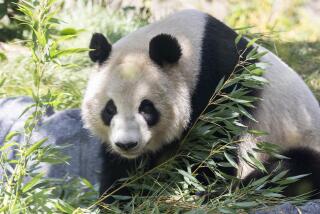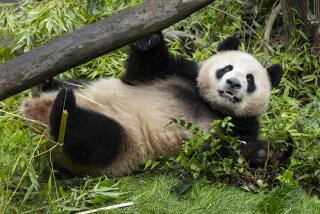Panda is getting help from National Zoo staff in caring for newborn twins
- Share via
Reporting from Washington — Interest in the impending birth of a panda at the National Zoo was so great this weekend that the famous “panda cam” crashed its Web page. And that was just for the first birth. Who knew the day would end with panda twins?
The pregnancy had escaped notice until just a few days ago. But by Saturday, Mei Xiang the giant panda was showing signs of preparing to give birth, and at 5:35 p.m., she did just that, with the zoo’s full panda team on hand to watch the intimate event.
The big surprise came a few hours later, revealed via Twitter: “We can confirm a second cub was born at 10:07. It appears healthy.”
As usual, the cubs were born pink, with wispy fur, and blind. It was not immediately apparent who their father was.
Their sex will be determined later, and their names will come sometime after that.
To give the cubs the best chance of survival, the zoo removed one cub, hand-fed it, gave it antibodies from Mei Xiang and placed it in an incubator.
“The panda team will alternately swap the cubs, allowing one to nurse and spend time with Mei Xiang while the other is being bottle-fed and kept warm in an incubator,” the zoo said on its website. “The primary goal … is for both cubs to have the benefit of nursing and spending time with their mother.”
Giant pandas give birth to twins about 50% of the time, the zoo said, but this is only the third time it has happened in the U.S. And survival is difficult.
“There are only two other female giant pandas around the world who have successfully reared twins, and it required a lot of human support,” the zoo said.
Panda lovers have known exhilaration and heartbreak before.
Two of Mei’s cubs have lived past infancy, 10-year-old Tai Shan and 2-year-old Bao Bao. But two babies born between them didn’t make it.
Mei’s predecessor pandas at the Washington zoo knew similar sorrow. The famous Ling-Ling and Hsing-Hsing, gifts from the Chinese government after President Nixon’s visit to China, had five cubs, none of whom lived beyond a few days.
The childless couple developed quite a following, though, drawing millions of visitors each year, and Mei and her young family have enjoyed a similar popularity.
Conservationists venerate the black-and-white bears, among the rarest animals in the world, as familiar symbols of their efforts to protect endangered species.
According to the International Union for Conservation of Nature, giant pandas are considered an endangered species. There are fewer than 2,500 pandas left in the wild, most of which are confined to the south-central region of China.
The San Diego Zoo announced this month that its giant panda was not pregnant, ending weeks of speculation. Zookeepers had been monitoring the panda to see whether she showed any behaviors consistent with pregnancy. The panda, Bai Yun, has had six cubs and is nearing the end of her reproductive years.
Americans, it turns out, just love the cuddly looking creatures and want to watch them for hours on their computer screens.
Veterinarians at the National Zoo were thrilled Wednesday when it looked as if a new one might be on the way. Mei did something rare that morning. Though in recent days she had “declined participating in ultrasounds,” as they wrote on their website that morning, that day she responded to the panda keepers’ calls.
The ultrasound showed what looked like a developing fetus, 4 centimeters long and due any time in the coming weeks.
A day earlier, out of concern for the pregnancy — or a “pseudopregnancy,” as they thought this might be — they had partially closed the David M. Rubenstein Family Giant Panda Habitat around Mei’s den. Tian Tian, the zoo’s adult male, and Bao Bao continued to entertain visitors in the panda house. (Tai Shan is now in China.)
On Saturday, the tension was building. Mei was restless, having contractions, licking her body and staying in her den — all behaviors consistent with a baby on the way, the zoo said in a post on its Facebook page.
As the zoo’s technology division worked to restore the panda cam, the experts tended to the expectant mother, whose water broke in the late afternoon.
“Hoping for a healthy cub,” the zoo said on Facebook. “May take a few hours.”
Just an hour later, the first cub was born. Mei had been inseminated in April with sperm from Tian Tian, the father of her other two offspring.
She also was inseminated with sperm from Hui Hui, a giant panda at China’s Wolong National Nature Reserve, in hopes of diversifying the genetics of the panda population in human care.
Those procedures, like most everything else in Mei’s life, were live-streamed on Twitter using Periscope and live-posted to Instagram under the hashtag #PandaStory.
The babies will have a modicum of privacy for a while. Bao Bao got a few months to herself before she made a public debut.
Times staff writers Steve Padilla and Connie Stewart in Los Angeles contributed to this report.
More to Read
Sign up for Essential California
The most important California stories and recommendations in your inbox every morning.
You may occasionally receive promotional content from the Los Angeles Times.











